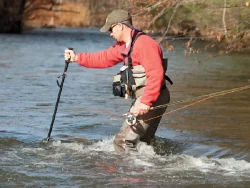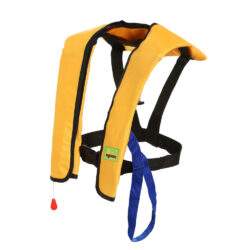Wading can be dangerous. Fishermen that wet wade or wear expensive waders, always try to get a little deeper. Their goal is to get closer to the fishing spot that others can’t reach. Recently an angler from Pennsylvania was wading and slipped under the water. He was found a few days later.
Hydraulics are important to understand. River currents change and are flowing in different directions at different speeds. Buoyancy is also an important factor. As the wader gets deeper, they become more buoyant, or ready to float. Now the fisherman’s center of balance changes.
While the angler goes deeper, starts to float, and can’t see under the water, the stage is set for an accident. The best-case scenario is that you may get soaking wet. The worst-case scenario is that you can drown.
Montana is full of bowling balls, round shaped rocks, that are left over from the ice age. When giant glaciers ground their way south, they bulldozed rocks. This rolling shaped the rocks. If you add algae to the rocks, these rolling rocks become even more slippery.
Once the angler falls into the water, they are at the mercy of the river. If a sprain, broken bone, or head injury happens, things will get worse. Not having full mobility, or clarity, will result in panic, and making poor choices. If the water is exceptionally cold, the shock of getting wet is also a concern. You have just moments to get to safety. If you panic, things will end poorly.
Smart anglers prevent accidents by using traction covered boots. Metal studs, and the new Vibram wading soles, add secure traction. A wading stick gives the angler more control. Folding wading shafts can be carried in a holster and are there when you need them. Smart anglers also know how to cast further and wade shallower.
Just because your boots are a certain height does not mean you need to fish that deep. Most feeding fish are in water less than 2 feet deep. If you need to cross a river, select a shallow tail out. Wading deeper than your waist is deeper than you need to be.
You can also wear an inflatable life vest. New designs can be worn discreetly and are available when needed. They fill with gas in an emergency and will keep your shoulders and head above water. This is especially important for lake waders.
Don’t wade if you can’t swim. Once you are in the water, face your feet downstream. Use your wading shaft to slow your drift. Your waders will fill with water, even if you are wearing a belt. If you don’t believe me, practice what happens in a river with a safety team in support.
Your downstream feet will allow you to push off any rocks or logs. Try to move against the current upstream, until you get into shallow water. You will not have any control if you are adrift. Try to hold onto your rod and use it to extend your sweeping arms. The longer rod will help to paddle backwards. Your other hand can handle the net to do the same thing.
I have seen hip booted waders nearly drown, in shallow water, due to panic. They broke their rods, lost gear, and swallowed water. In these cases, the anglers could not swim.
Fishing with friends is always a good idea. Having safety support could save your life. At the very least, have an emergency kit on hand. Start with a waterproof phone or emergency beacon. Fire starting materials are also important. Once you are out of the water, the next concern is hypothermia. Most hypothermia deaths happen in temperatures over 75 degrees!
If you fish some waters often, hide a cache nearby. This may contain a tarp, fire fixins, energy bars, water, or first aid gear. Once there is an emergency, you will have a place to recover.
No fish is worth drowning over. Wade within your limits and skill level. Older anglers tend to fall victim to their own pride. Younger anglers are less cautious since they feel more immortal.
Fish shallower, safer, and catch more fish!
Montana Grant